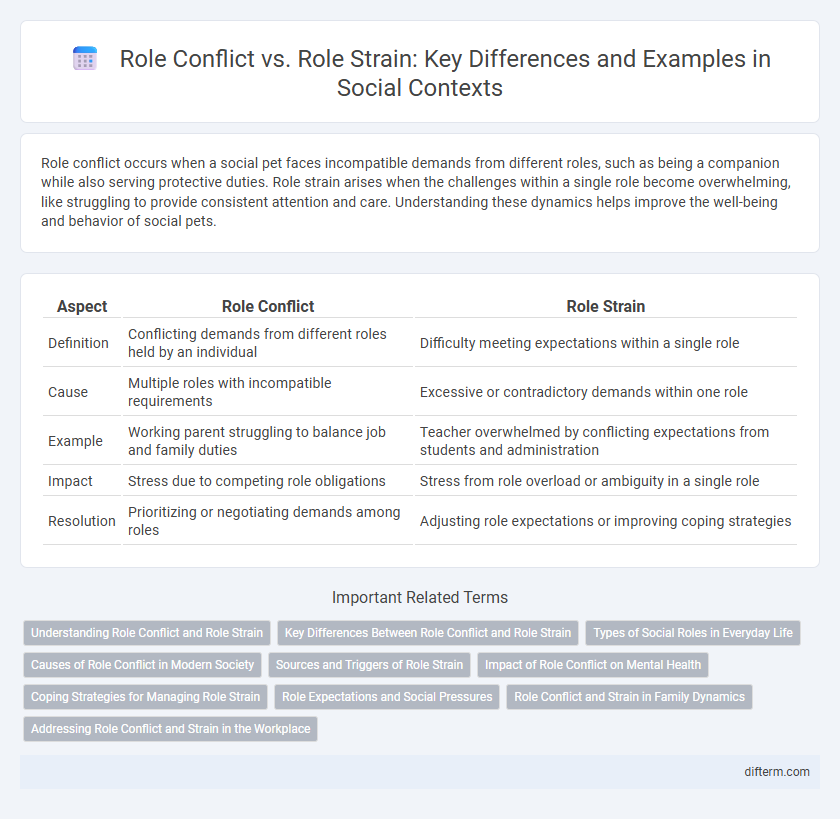Role conflict occurs when a social pet faces incompatible demands from different roles, such as being a companion while also serving protective duties. Role strain arises when the challenges within a single role become overwhelming, like struggling to provide consistent attention and care. Understanding these dynamics helps improve the well-being and behavior of social pets.
Table of Comparison
| Aspect | Role Conflict | Role Strain |
|---|---|---|
| Definition | Conflicting demands from different roles held by an individual | Difficulty meeting expectations within a single role |
| Cause | Multiple roles with incompatible requirements | Excessive or contradictory demands within one role |
| Example | Working parent struggling to balance job and family duties | Teacher overwhelmed by conflicting expectations from students and administration |
| Impact | Stress due to competing role obligations | Stress from role overload or ambiguity in a single role |
| Resolution | Prioritizing or negotiating demands among roles | Adjusting role expectations or improving coping strategies |
Understanding Role Conflict and Role Strain
Role conflict occurs when an individual faces incompatible demands from multiple social roles, such as a parent who must balance work responsibilities and child care simultaneously. Role strain happens when conflicting expectations arise within a single social role, like a teacher struggling to meet administrative duties while effectively engaging students. Understanding these distinctions helps in managing stress and improving social interactions by identifying specific sources of role-related tension.
Key Differences Between Role Conflict and Role Strain
Role conflict occurs when an individual faces incompatible demands from different social roles, such as balancing work and family responsibilities, leading to tension between distinct expectations. Role strain, however, arises from difficulties within a single role, where competing demands or expectations create stress, like a teacher managing diverse student needs. The key difference lies in role conflict involving multiple roles and role strain stemming from challenges within one role.
Types of Social Roles in Everyday Life
Role conflict occurs when incompatible demands arise from different social roles, such as managing work responsibilities while fulfilling family obligations, whereas role strain involves tension within a single role due to contradictory expectations, like meeting diverse job demands at work. Common types of social roles in everyday life include familial roles, occupational roles, and community or social group roles, each generating unique challenges related to conflicting or strained expectations. Understanding the distinctions between role conflict and role strain helps individuals navigate the complexities of balancing multiple social commitments and maintaining psychological well-being.
Causes of Role Conflict in Modern Society
Role conflict arises in modern society when individuals face incompatible demands from multiple social roles, such as balancing professional responsibilities with family obligations. Causes include rapid social change, increased work-life integration challenges, and diverse cultural expectations that create contradictory pressures. Technological advancements and globalized communication further exacerbate role conflict by blurring boundaries between personal and professional roles.
Sources and Triggers of Role Strain
Role strain arises from conflicting demands within a single social role, often triggered by high expectations, limited resources, or ambiguous role definitions, leading to stress and decreased performance. Common sources include workload overload, incompatible tasks, and unclear role responsibilities in contexts such as employment or family roles. Understanding these triggers helps in designing effective interventions to alleviate tension and improve role management.
Impact of Role Conflict on Mental Health
Role conflict occurs when incompatible demands arise from multiple social roles, leading to increased stress and anxiety that negatively affect mental health. This internal struggle often results in decreased psychological well-being, manifesting as depression, burnout, and reduced coping capacity. Understanding and mitigating role conflict is crucial for promoting mental resilience and overall emotional stability.
Coping Strategies for Managing Role Strain
Effective coping strategies for managing role strain include time management techniques, setting realistic expectations, and seeking social support to alleviate stress associated with multiple demands. Engaging in mindfulness practices and prioritizing self-care can enhance emotional resilience, allowing individuals to better balance conflicting role pressures. Developing clear communication and boundary-setting skills also helps reduce role strain by clarifying responsibilities and minimizing overlap between competing roles.
Role Expectations and Social Pressures
Role conflict arises when incompatible role expectations from different social positions create competing demands, leading to stress and difficulty in fulfilling responsibilities. Role strain occurs within a single social role when excessive or conflicting expectations impose pressures, causing tension and decreased performance. Managing these social pressures requires balancing the demands of multiple roles or negotiating expectations within one role to maintain social harmony and individual well-being.
Role Conflict and Strain in Family Dynamics
Role conflict in family dynamics occurs when individuals face incompatible demands from different social roles, such as balancing work responsibilities with caregiving duties, leading to increased stress and tension. Role strain arises when the expectations within a single role, like parenting, become overwhelming and difficult to fulfill effectively, causing emotional distress. Both role conflict and role strain can disrupt family cohesion and communication, impacting overall relational well-being.
Addressing Role Conflict and Strain in the Workplace
Addressing role conflict and role strain in the workplace involves implementing clear communication strategies and defining role expectations for employees. Employers can reduce stress by promoting role clarity, offering support resources, and encouraging work-life balance initiatives. Effective management of role conflict and strain enhances employee satisfaction, productivity, and overall organizational health.
role conflict vs role strain Infographic

 difterm.com
difterm.com